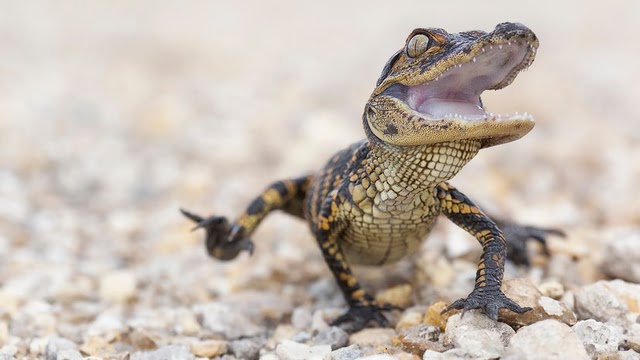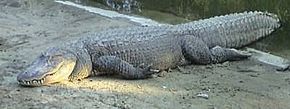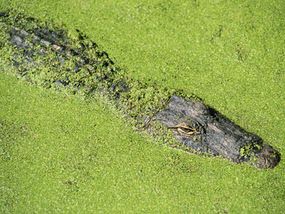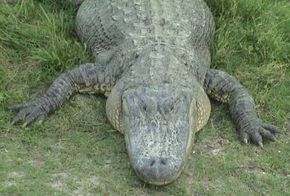Quck answer
Alligators are large, semi-aquatic reptiles that can be found in the southeastern United States and parts of China. They have powerful jaws and teeth, which they use to hunt for prey in the water. Alligators also have a unique respiratory system, allowing them to stay underwater for extended periods of time. They are cold-blooded animals, meaning their body temperature varies with the temperature of their environment. Alligator populations have been threatened by habitat loss and hunting, but conservation efforts have helped to stabilize their numbers in some areas.
Wild Animals

Alligators have been able to survive on Earth for millions of years due to their remarkable adaptability. These living dinosaurs are found in states like Florida, Georgia, Alabama, and Louisiana, where their environment is well-suited to their needs. They are fascinating creatures that possess unique abilities that keep them alive and thriving even in the harshest of conditions.
- Alligators can go for up to three years without food.
- Alligators are one of the few reptiles that take care of their young.
- Alligators have vibration sensors on their skin that can detect even the slightest movement and alert them to potential danger.
Despite their impressive abilities, alligators can be extremely dangerous. These instinctual creatures will eat anything that moves when they are hungry, and pets and children are often their victims. Their brain weighs only 8 or 9 grams, which means they are incapable of being “nice alligators.”
American Alligators

Your basic alligator has a large head, a lizard-like body, four stubby legs, and a long tail.
American alligators belong to the Crocodylia order, which includes 23 different species, such as Caimans and various crocodiles. These living dinosaurs have been around for over 180 million years and have the same basic body form, featuring a large head, a long, lizard-like body, four stubby legs, and a long tail.
Male alligators can grow up to 11 feet (3.5 meters) long and weigh around 600 pounds (270 kg), while females are around 8 feet long and weigh about half as much as males. Males can weigh up to 1,000 pounds, and Utan, a large crocodile in Myrtle Beach, SC, weighs 2,000 pounds and is almost 20 feet long. Alligators are freshwater creatures found in lakes, rivers, ponds, and irrigation canals in the southeastern United States.
Although some captive alligators have lived to be over 100 years old, their typical lifespan in the wild is around 40 years.
Alligator Features

Alligator spikes on their back are called scutes, which are bones that protect the alligator from potential threats.
Alligators have numerous unique features that have allowed them to survive on Earth for millions of years. Their remarkable adaptability is a testament to their ability to thrive in even the most extreme conditions.
Alligators have a tough exterior due to bony plates, known as osteoderms or scutes, located within their skin. These plates make it difficult for predators to penetrate their skin. The ridges on the back of an alligator are formed by a piece of bone within the skin. Despite their size and cold-blooded nature, alligators are capable of running at speeds up to 11 MPH (17 KPH) over short distances, which allows them to escape danger on land and retreat to the water. Alligator eyes have two sets of eyelids, with the inner lids providing protection and clearer vision underwater. When swimming, alligators are capable of staying underwater for up to 20 minutes, with a maximum of two hours at rest and up to eight hours in very cold water. However, alligators can only exert themselves for about 30 minutes before becoming completely exhausted, making them vulnerable to capture. Alligators are opportunistic eaters, consuming a variety of prey including fish, turtles, frogs, birds, and even larger mammals like deer. They use their tails to propel themselves up to 5 feet out of the water to capture prey.

An alligator can be difficult to spot when lurking in the shadows at a pond’s edge. Only the eyes and nostrils are above the waterline, allowing the alligator to wait for prey to come nearby. Once the prey is close enough, the alligator quickly moves to capture it. Alligators have skin sensors that are highly sensitive to vibrations, allowing them to detect any disturbance in the water. Once caught, the alligator holds its prey in its mouth and drags it underwater to drown it before breaking bones or crushing shells to create a chunk of flesh that can fit down its throat. Alligators are cold-blooded and only need to eat once a week, storing excess calories in fat deposits at the base of their tail. They can last more than two years between feedings by burning these fat reserves.
Alligator Breeding

Alligators were once endangered due to hunting, but their unique breeding behaviors allowed them to recover quickly once they were protected. Females build nests of mud and vegetation in the spring and lay 30 to 50 eggs, which they bury in the rotting vegetation. The heat generated by the decomposing vegetation provides warmth for the eggs, and the temperature determines the gender of the hatchlings. The mother alligator protects the nest from predators while the eggs are incubating, and when they hatch, she digs them out of the nest. The hatchlings and mother stay near the nest, and the mother will protect the hatchlings if they cry out for help. This protective behavior is rare in modern reptiles but is thought to be common in certain dinosaur species.
Besides its eyes and ears, alligators are equipped with skin sensors that are incredibly sensitive to vibration. These sensors make it possible for an alligator to detect anything entering the water or disturbing the surface of the water anywhere nearby.
Alligators, being cold-blooded, do not have to eat very often. Once a week is a typical feeding schedule for alligators living in the wild. Excess calories are stored in fat deposits at the base of the alligator’s tail. Incredibly, by burning fat reserves, it is possible for an alligator to last more than two years between feedings.
Alligators can digest anything they swallow, including muscle, bone, and cartilage. They have incredibly powerful jaws that can exert up to 2,000 PSI, allowing them to break bones or crush shells to create a chunk of flesh that can fit down their throat. They raise their head, open the palatal valve, and swallow the piece whole before digesting it completely.
Hibernation of Alligators

During the winter season, alligators tend to slow down their activities. They stop eating when the temperature falls below 70 degrees F. Moreover, when the temperature decreases further, they dig a den in the bank of a river or pond and remain inactive until the temperature rises again.
Alligators are capable of surviving freezing temperatures as well. They float to the surface of the water if the water is on the verge of freezing, with their nostrils above the surface, thereby allowing them to breathe through the ice as it forms. In extreme cases, they can even get frozen into the surface of the pond for a few days and then swim freely after the ice melts. Detailed information can be found on this page.
В
Further Details
Related Articles on HowStuffWorks
- How Animal Camouflage Works
- How Mosquitoes Work
- How Bats Work
- How Sharks Work
- How Evolution Works
- How Body Armor Works
- How Whales Work
- How Spiders Work
- Alligator Quiz
More Useful Links
- Crocodilian Biology Database
- American Alligator Fact Sheet
- American Alligator Info
FAQ
1. What are alligators?
Alligators are large reptiles that belong to the crocodilian family. They are similar to crocodiles but have a wider and shorter snout. They are native to the southeastern United States and are commonly found in freshwater areas such as swamps, rivers, and lakes.
2. How big do alligators get?
Alligators can grow up to 14 feet in length and can weigh up to 1,000 pounds. The males tend to grow larger than females and can reach their full size at around 20 years old.
3. What do alligators eat?
Alligators are carnivores and eat a variety of prey such as fish, turtles, birds, and mammals. They are opportunistic feeders and will eat almost anything that comes within their reach, including other alligators.
4. How do alligators hunt?
Alligators use their powerful jaws to catch and hold their prey. They have a unique method of hunting called the “death roll” where they grab onto their prey and spin rapidly in the water to disorient it. This makes it easier for them to swallow their prey whole.
5. How do alligators survive in cold weather?
Alligators are cold-blooded reptiles, which means they cannot regulate their body temperature. During colder months, they will burrow into mud or sand and become dormant. They slow down their metabolism and can go for months without eating or drinking.
6. Are alligators dangerous to humans?
Alligators have been known to attack humans, especially if they feel threatened or if their habitat is disturbed. It is important to never approach an alligator and to stay away from their habitat. If you encounter an alligator, it is best to slowly back away and seek help from a professional.
7. How are alligators important to their ecosystem?
Alligators play an important role in their ecosystem by controlling the population of other animals and maintaining the balance of their habitat. They are also an indicator species, which means they are used as a measure of the health of their environment.





Leave a Reply